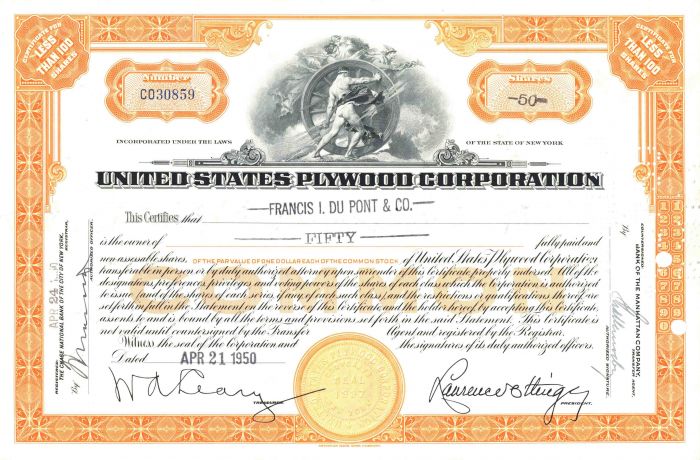United States Plywood Corporation - Stock Certificate
Inv# GS6280 Stock
Stock printed by American Bank Note Company.
Plywood is a material manufactured from thin layers or "plies" of wood veneer that are glued together with adjacent layers having their wood grain rotated up to 90 degrees to one another. It is an engineered wood from the family of manufactured boards which include medium-density fibreboard (MDF), oriented strand board (OSB) and particle board (chipboard).
All plywoods bind resin and wood fibre sheets (cellulose cells are long, strong and thin) to form a composite material. This alternation of the grain is called cross-graining and has several important benefits: it reduces the tendency of wood to split when nailed at the edges; it reduces expansion and shrinkage, providing improved dimensional stability; and it makes the strength of the panel consistent across all directions. There is usually an odd number of plies, so that the sheet is balanced—this reduces warping. Because plywood is bonded with grains running against one another and with an odd number of composite parts, it has high stiffness perpendicular to the grain direction of the surface ply.
Smaller, thinner, and lower quality plywoods may only have their plies (layers) arranged at right angles to each other. Some better-quality plywood products will by design have five plies in steps of 45 degrees (0, 45, 90, 135, and 180 degrees), giving strength in multiple axes.
The word ply derives from the French verb plier, "to fold", from the Latin verb plico, from the ancient Greek verb πλέκω.
The ancient Egyptians and Greeks cut wood thinly and glued it together in layers with the grain in perpendicular directions, making a versatile building material. In 1797 Samuel Bentham applied for patents covering several machines to produce veneers. In his patent applications, he described the concept of laminating several layers of veneer with glue to form a thicker piece – the first description of what we now call plywood. Bentham was a British naval engineer with many shipbuilding inventions to his credit. Veneers at the time of Bentham were flat sawn, rift sawn or quarter sawn; i.e. cut along or across the log manually in different angles to the grain and thus limited in width and length.
About fifty years later Immanuel Nobel, father of Alfred Nobel, realized that several thinner layers of wood bonded together would be stronger than a single thick layer of wood. Understanding the industrial potential of laminated wood, he invented the rotary lathe.
There is little record of the early implementation of the rotary lathe and the subsequent commercialization of plywood as we know it today, but in its 1870 edition, the French dictionary Robert describes the process of rotary lathe veneer manufacturing in its entry Déroulage. One can thus presume that rotary lathe plywood manufacturer was an established process in France in the 1860s. Plywood was introduced into the United States in 1865 and industrial production there started shortly after. In 1928, the first standard-sized 4 ft by 8 ft (1.2 m by 2.4 m) plywood sheets were introduced in the United States for use as a general building material.
Artists use plywood as a support for easel paintings to replace traditional canvas or cardboard. Ready-made artist boards for oil painting in three-layered plywood (3-ply) were produced and sold in New York as early as 1880.
A stock certificate is issued by businesses, usually companies. A stock is part of the permanent finance of a business. Normally, they are never repaid, and the investor can recover his/her money only by selling to another investor. Most stocks, or also called shares, earn dividends, at the business's discretion, depending on how well it has traded. A stockholder or shareholder is a part-owner of the business that issued the stock certificates.











Ebay ID: labarre_galleries